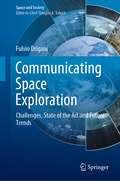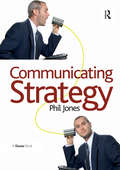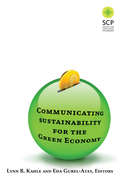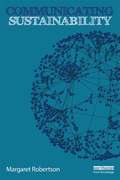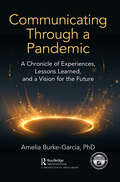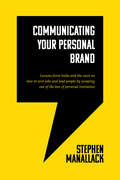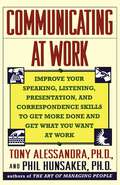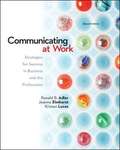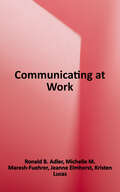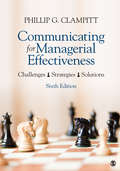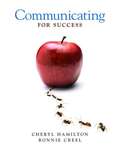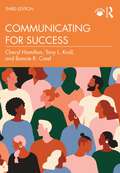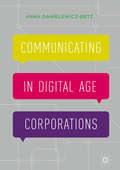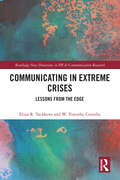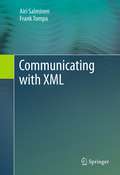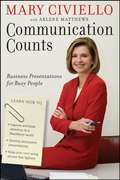- Table View
- List View
Communicating Space Exploration: Challenges, State of the Art and Future Trends (Space and Society)
by Fulvio DriganiThis book offers an enlightening analysis of the ways in which the communication of space explorations has evolved in response to political and social developments and the availability of new media and communication tools. Important challenges to effective communication are discussed, including the diversity of audiences, the risks associated with space missions, and continuing skepticism about the benefits of space research despite the many associated day-to-day applications. In addition, future trends in communication are examined with reference to likely trends in space exploration over the coming century. Besides space communication for the public, the need for targeted messaging to each group of stakeholders – decision makers, media, opinion leaders, the scientific community, and industry – is analyzed in detail. A series of case studies of particular space missions, both successful and unsuccessful, is presented to illustrate key issues. The book has significant implications for the communication of science in general and will be of interest to a wide audience, including space scientists, science communication professionals, people fascinated by exploration and discovery, stakeholders, and educators.
Communicating Strategy
by Phil Jones'If you don't communicate your strategy in a way that your people understand and find compelling, how can you expect them to help you succeed with it? Research suggests only 5% of the people in an organization understand its strategy. If that is true for your organization, whose strategy are the other 95% implementing? Not yours, that is for sure.' Phil Jones' Communicating Strategy is designed to help you communicate your strategy in a compelling and effective way, and dramatically improve implementation and the resulting outcomes. It provides a clear framework for building a communication plan as well as practical information, techniques, tools, tips and exercises that can be applied to explain and deliver a complete and coherent message. With guidance on how to create change champions, the book is vital reading for senior managers globally.
Communicating Sustainability for the Green Economy: Communicating Sustainability For Green Economy
by Eda Gurel-Atay Lynn R KahleWith chapters written by experts in their field, this volume advances the understanding of theory and successful practice of marketing and promoting environmental sustainability. Some experts predict that the next big trend in business will involve the green economy. Yet, communicating sustainability to consumers provides a set of challenges for marketers that do not necessarily follow all the rules of other types of marketing communication. In many ways the concept of sustainability challenges the core ideals of promoting consumption. Accordingly, this book identifies for researchers and practitioners the barriers that keep customers from engaging in environmentally sustainable consumption and find ways to overcome those barriers. The book includes topics such corporate advertising strategy related to sustainability, corporate social responsibility advertising, greenwashing, advertising related to values, persuasion and persuasion knowledge in sustainability marketing, social media and sustainability, and advertising and public policy.
Communicating Sustainability: Making Sustainability Legible
by Margaret RobertsonCommunicating Sustainability is a book of evidence-based strategies for making sustainability vivid, accessible, and comprehensible. To do this, it brings together research from a range of specialties including cognitive psychology, visual perception, communication studies, environmental design, interpretive exhibit design, interpretive signage, wayfinding, storytelling, courtroom litigation, information graphics, and graphic design to illustrate not only what approaches are effective but why they work as they do. The topic of sustainability is vast and complex. It interconnects multiple dimensions of human culture and the biosphere and involves a myriad of systems and processes, many of which are too large, too small, too fast, or too slow to see. Many people find verbal explanations about all of this too abstract or too complicated to understand, and for most people the concepts of sustainability are regarded as quirky, peripheral, and not essential to everyday life. Yet the challenges of sustainability concern the very survival of most species of life on Earth, including the human species. In order for life as we know it to survive and thrive into the future, sustainability must become broadly understood—by everyone, not just activists or specialists. This book offers tools to help make complex systems and nuanced, abstract ideas concrete and comprehensible to the broadest range of people. The goal of communication, and of this book, is to build understanding.
Communicating Through a Pandemic: A Chronicle of Experiences, Lessons Learned, and a Vision for the Future
by Amelia Burke-GarciaOutbreaks, epidemics, and pandemics are nothing new. Over the last several decades, we have been through numerous—Zika, Ebola, H1N1. The COVID‐19 pandemic, however, has challenged us like never before. During this time, we have struggled to work remotely, to balance work and children’s school schedules, and to manage finances in the face of lost or furloughed jobs. We have worried about our loved ones getting sick and being able to support themselves, and we have faced the loneliness that comes with social distancing. It has affected us individually and globally—but we have not all experienced this pandemic in exactly the same way. Some communities have been hit harder in terms of sickness and death rates from COVID‐19. Many have felt the economic pressures of the pandemic more acutely. Still others have struggled disproportionately with the mental health impacts. Context has mattered in this pandemic. There is one common thread that runs through everything we have experienced though: the role that communication has played in managing this pandemic. Whether we are talking about communication about the virus and mitigation strategies, communication between friends and family, the urgent crisis resulting in mis- and dis-information, our complex and diffuse media environment, or new workplace communication strategies, communication has been front and center in this pandemic. The role of communication has been integral to the success and failure of our ability to respond and adapt to and begin to recover from this pandemic—as individuals, collectively as communities, and as countries. As a result, issues such as preparedness, misinformation, literacy and comprehension of virus and vaccine science, health equity and mental health have all gained increased awareness during this time. This book unpacks the many and varied roles that communication has played over the course of this pandemic, in order to help public health professionals, marketers and health communicators, and policymakers alike to understand what we have been through, what has worked well, and what we have struggled with. It will help us learn from our experiences, so we communicate through pandemics more successfully in the future.
Communicating Through a Pandemic: A Chronicle of Experiences, Lessons Learned, and a Vision for the Future
by Amelia Burke-GarciaSilver Award Winner from the Nonfiction Authors Association“The book is equal parts ‘how-to guide’ for effective health communications and a memoir of surviving a global pandemic. I appreciated reading about Burke-Garcia’s personal reflections about her experiences of isolation, uncertainty and exhaustion during quarantine. She shares her experiences and observations in a relatable and accessible manner. Knowing about the author’s personal struggles made me lean into what she had to share from her professional experience leading a communications campaign. Throughout the book, she explores data and research about communication needs among people from diverse groups and presents a sensible critique of the media environment.” – Nonfiction Book AwardOutbreaks, epidemics, and pandemics are nothing new. Over the last several decades, we have been through numerous—Zika, Ebola, H1N1. The COVID‐19 pandemic, however, has challenged us like never before. During this time, we have struggled to work remotely, to balance work and children’s school schedules, and to manage finances in the face of lost or furloughed jobs. We have worried about our loved ones getting sick and being able to support themselves, and we have faced the loneliness that comes with social distancing.It has affected us individually and globally—but we have not all experienced this pandemic in exactly the same way. Some communities have been hit harder in terms of sickness and death rates from COVID‐19. Many have felt the economic pressures of the pandemic more acutely. Still others have struggled disproportionately with the mental health impacts. Context has mattered in this pandemic.There is one common thread that runs through everything we have experienced though: the role that communication has played in managing this pandemic. Whether we are talking about communication about the virus and mitigation strategies, communication between friends and family, the urgent crisis resulting in mis- and dis-information, our complex and diffuse media environment, or new workplace communication strategies, communication has been front and center in this pandemic.The role of communication has been integral to the success and failure of our ability to respond and adapt to and begin to recover from this pandemic—as individuals, collectively as communities, and as countries. As a result, issues such as preparedness, misinformation, literacy and comprehension of virus and vaccine science, health equity and mental health have all gained increased awareness during this time.This book unpacks the many and varied roles that communication has played over the course of this pandemic, in order to help public health professionals, marketers and health communicators, and policymakers alike to understand what we have been through, what has worked well, and what we have struggled with. It will help us learn from our experiences, so we communicate through pandemics more successfully in the future.
Communicating Your Personal Brand: Lessons from India and the west on how to win jobs and lead people by jumping out of the box of personal limitation
by Stephen ManallackCommunicating Your Personal Brand by Stephen Manallack combines lessons from India and the west on how to win jobs and lead people. • How to jump out of the box of personal limitation • 20 soft skills for 21st century global communicators • Win that special job - Gain the promotion you deserve • Change the way you see yourself, and the way others see you • Communicate across borders • Have the mindset of a leader - lessons from India • A must read for young executives, professionals, students and those on the career path Stephen Covey: "Communication is the most important skill in life" Sir Richard Branson: "Communication is the most important skill any leader can possess"
Communicating and Organizing in Complex Operational Situations: An Empirical Study of Communication Structures in Staff Work
by Jana M. CeliklerJana M. Celikler examines the creation, maintenance, and design of communication structures and processes within situation briefings in the staff work of civil and disaster protection organizations. Based on a conversation analysis of 45 situation briefings, which the author documented through participant observation, she develops a phase model that represents the individual phases in the communication process of a situation briefing, taking into account phase-specific communication patterns. Based on her findings, she formulates design recommendations for conducting situation briefings.
Communicating at Work
by Tony AlessandraIn today's competitive workplace, your ability to communicate is your most important business skill.This valuable handbook to better business communication can help you develop the skills you need to succeed. Using real-life examples, it offers practical, easy-to-use instruction in writing effective memos and reports, making memorable presentations, and leading productive meetings. It also introduces key telephone skills, shows you how to interpret body language and personal communication styles -- and teaches you the critical listening and questioning skills you need to get ahead.Whether you're a top manager trying to lead a large organization or one of the millions of people who actually get the work done, Communicating at Work can help you be more effective, get more of what you want out of work, and improve your chances for success.
Communicating at Work: Strategies For Success in Business and the Professions (11th Edition)
by Ronald B. Adler Jeanne Marquardt Elmhorst Kristen LucasThe 11th edition of Communicating at Work enhances the strategic approach, real-world practicality, and reader-friendly voice that have made this text the market leader for three decades. On every page, students learn how to communicate in ways that enhance their own career success and help their organization operate effectively. This edition retains the hallmark features that have been praised by faculty and students--a strong emphasis on ethical communication and cultural diversity, discussions of evolving communication technologies, and self-assessment tools--while incorporating important updates and ground-breaking digital teaching and learning tools to help students better connect to the course material and apply it to real world business situations.
Communicating at Work: Strategies for Success in Business and the Professions
by Ronald B. Adler Jeanne Marquardt Elmhorst Kristen Lucas Michelle Marie MareshThis book provides students with strategies that are rooted in current research and real-world best practices. With Communicating at Work, students will gain the tools they need to make informed and ethical decisions in face-to-face and virtual environments and to master practical skills and competencies necessary for succeeding and maintaining balance in todays business world.
Communicating for Managerial Effectiveness: Challenges | Strategies | Solutions
by Phillip G. ClampittAppreciated by thousands of thoughtful students, successful managers, and aspiring senior leaders around the world Communicating for Managerial Effectiveness skillfully integrates theory, research, and real-world case studies into models designed to guide thoughtful responses to complex communication issues. The highly anticipated Sixth Edition builds on the strategic principles and related tactics highlighted in previous editions to show readers how to add value to their organizations by communicating more effectively. Author Phillip G. Clampitt (Blair Endowed Chair of Communication at the University of Wisconsin–Green Bay) addresses common communication problems experienced in organizations, including: Communicating about major changes spanning organizational boundaries Selecting the proper communication technologies Transforming data into knowledge Addressing ethical dilemmas Providing useful performance feedback Structuring and using robust decision-making practices Cultivating the innovative spirit Building a world-class communication system
Communicating for Managerial Effectiveness: Challenges | Strategies | Solutions
by Phillip G. ClampittAppreciated by thousands of thoughtful students, successful managers, and aspiring senior leaders around the world Communicating for Managerial Effectiveness skillfully integrates theory, research, and real-world case studies into models designed to guide thoughtful responses to complex communication issues. The highly anticipated Sixth Edition builds on the strategic principles and related tactics highlighted in previous editions to show readers how to add value to their organizations by communicating more effectively. Author Phillip G. Clampitt (Blair Endowed Chair of Communication at the University of Wisconsin–Green Bay) addresses common communication problems experienced in organizations, including: Communicating about major changes spanning organizational boundaries Selecting the proper communication technologies Transforming data into knowledge Addressing ethical dilemmas Providing useful performance feedback Structuring and using robust decision-making practices Cultivating the innovative spirit Building a world-class communication system
Communicating for Success
by Cheryl M. Hamilton Bonnie CreelThis book focuses on the key communication competencies recommended by the National Communication Association. Introduced at the beginning of each chapter and integrated throughout the book, these learning outcomes help focus readers as they study the theory and skills needed to become better, more effective communicators. Well-written with interesting examples and a vibrant and engaging design, the book covers all the expected topics in an introductory course with a special appendix on interviewing. Each chapter begins with scenarios to which a reader can relate and then solve as they learn about the concepts discussed in each chapter. A concentrated focus on careers in communication, highlighted in a two-page spread near the end of each chapter, brings home the relevance of communication within the real world and helps the reader learn more about how studying communication can help them throughout their lives. Additional emphasis on topics such as ethics, culture, gender, and technology can be found throughout the book.
Communicating for Success
by Bonnie Creel Cheryl R. Hamilton Tony L. KrollCommunicating for Success, third edition, is a core textbook for Introduction to Communication courses and gives students an overview of the subfields of Communication Studies and how these areas provide practical, fun, and immediate applications to students pursuing a wide variety of career paths, as well as practical instruction in public speaking for success on today’s social media platforms. This fully updated third edition focuses on the key communication competencies recommended by the National Communication Association, including verbal and nonverbal communication, listening, interpersonal communication and conflict resolution, group and organizational communication, public speaking, leadership, and the roles of social media, technology, culture, gender, and ethics in communication. With a vibrant and engaging design, this volume is packed with applied features including practical scenarios and examples, key terms, discussion questions, sample activities, learning objectives, and more. A concentrated focus on the influence of communication on careers in business, education, and healthcare is highlighted in a two-page career spread at the end of each chapter and takes lessons beyond the classroom. New features in this edition include a greater focus on public speaking in the workplace; emphasis on demographic and behavioral factors in audience analysis; and increased discussion of issues of social justice and equity. Online resources for instructors include PowerPoint slides and an Instructor’s Manual with guidance on how to use the book’s activities in both in-person and online courses.
Communicating in Digital Age Corporations
by Anna Danielewicz-BetzThe distinctive point of the book is its innovative interdisciplinary approach to business communication, with interconnections between linguistics, sociology, and critical organisational studies as applied to the corporate world. It offers a first-hand insight into primary business discourse with a deeper understanding and analysis of business processes and mechanisms underlying and reflected in enterprise software-mediated communication. It answers the question what 'doing business' in the digital age is about and illustrates 'business discourse' from practitioners' point of view. Grounded in the analysis of empirical data, pertaining both to internal and external business communication, the author reflects on the reality of accelerated and pressurised communication in global IT corporations. Following a communication-centred approach, this monograph puts the topic of enterprise software-mediated business discourse into a multi-layered perspective of how global corporations operate, what their primary goals are, and what kind of (political) power they execute. Moreover, it demonstrates how profit-driven corporations can be viewed and interpreted as strategically acting systems within a specific sociological framework.
Communicating in Extreme Crises: Lessons from the Edge (Routledge New Directions in PR & Communication Research)
by W. Timothy Coombs Elina TachkovaThis book is an evidence-based approach to handling common, extreme crises. Extreme crises involve strong moral outrage; moral outrage creates situations where traditional crisis communication advice no longer is effective. These extreme crises create unique demands for crisis managers. Moreover, much of the traditional advice and crisis key performance indicators (KPIs) no longer apply. Validated through research, the book establishes the nature of extreme crises, the optimal crisis response for such crises, and the KPIs (outcomes) crisis managers need to measure for extreme crises. It serves as a guide for how to communicate effectively during extreme crises and provides advice based upon experimental research that validates the effectiveness of the crisis communication interventions. Readers do not require prior knowledge about crisis communication and crisis management as the book contains summaries of crisis communication and management before exploring the more specialized topic of extreme crises. Chapters include extended case studies, examining communication within such events as the Westpac money laundering, VW emissions and COVID-19 crises. Communications in Extreme Crises will be of direct interest to scholars of crisis communication in public relations, corporate communication, strategic communication, organizational communication programs and management.
Communicating the Change Vision: Overcoming Barriers to Organizational Change
by John P. KotterCommunicating a vision for change and gaining understanding and commitment to a new direction is never an easy task, especially in large enterprises. However, the new vision must be constantly and effectively communicated in order to create a shared sense of a desirable future, which helps motivate and coordinate the transformation effort. This chapter was originally published as Chapter 6 of "Leading Change."
Communicating with Data: Making Your Case With Data
by Carl AllchinData is a fantastic raw resource for powering change in an organization, but all too often the people working in those organizations don't have the necessary skills to communicate with data effectively. With this practical book, subject matter experts will learn ways to develop strong, persuasive points when presenting data to different groups in their organizations.Author Carl Allchin shows anyone how to find data sources and develop data analytics, and teaches those with more data expertise how to visualize data to convey findings to key business leaders more effectively. Once both your business and data experts possess the skills to work with data and interpret its significance, you can deal with questions and challenges in departments across your organization.Learn the fundamental data skills required to work with dataUse data visualization to influence change in your organizationLearn how to apply data techniques to effectively work with data end to endUnderstand how to communicate data points clearly and persuasivelyAppreciate why different stakeholders often have divergent needs and viewsCreate a playbook for using data with different departments
Communicating with XML
by Airi Salminen Frank TompaThis book provides extensive insight into the possibilities and challenges of XML in building new information management solutions in networked organizations. After a brief introduction to Web communication features and XML fundamentals, the book examines the benefits of adopting XML and illustrates various types of XML use: XML in document management; XML for data-centric and multimedia components; XML as a format for metadata, including metadata for the Semantic Web; and XML in support of data interchange between software applications and among organizations. The challenges of adopting XML in large-scale information management are also discussed. In addition, applications across a broad spectrum are examined and numerous case studies pertaining to the adoption of XML are presented. The book is particularly suitable for courses offered in Information Studies, Information Systems, or Information Technology. It also serves as an excellent practical guide for professionals in information management and provides important support material for courses in Computer Science and in Business.
Communication Across Cultures
by Heather Bowe Kylie MartinCommunication Across Cultures is an academic reference for university students and interdisciplinary researchers who have no specialised knowledge of linguistics. Key concepts relevant to an understanding of language issues in intercultural communication are drawn from the research area of pragmatics, discourse analysis, politeness and cross cultural communication. The book examines the ways in which the spoken and written word may be interpreted differently depending on the context and expectations of the participants. Intercultural communication involves additional sociocultural dimensions to the context. Examples are drawn from a variety of languages and cultures - ranging from Japan to Germany to the Americas, to Africa and to Australia. Relevant academic literature and recent research is exemplified and explained throughout the book so readers can become familiar with the way research in this field is conducted and so that interdisciplinary researchers can incorporate some of the perspectives presented here into their own research.
Communication Across Cultures
by Heather Bowe Kylie Martin Heather Bowe Kylie Martin Howard MannsCommunication Across Cultures explores how cultural context affects the use and (mis)interpretation of language. It provides an accessible and interdisciplinary introduction to language and language variation in intercultural communication by drawing on both classic and cutting-edge research from pragmatics, discourse analysis, sociolinguistics, linguistic anthropology and politeness studies. This new edition has been comprehensively updated to incorporate recent research, with an emphasis on the fluid and emergent practice of intercultural communication. It provides increased coverage of variation in language within and between cultures, drawing on real-world examples of spoken and written communication. The authors review classic concepts like 'face', 'politeness' and 'speech acts', but also critique these concepts and introduce more recent approaches. Each chapter provides a set of suggested readings, questions and exercises to enable the student to work through concepts and consolidate their understanding of intercultural communication. This is an excellent resource for students of linguistics and related disciplines.
Communication Campaigns and National Integration in China's Market Economy Era: Reviving the National Soul
by Yanru ChenThis book adopts the method of grounded theory in studying national communication campaigns in China, referred to as propaganda campaigns in the Chinese linguistic context. The study provides an exploratory and descriptive analysis of the ways in which the media in China fulfilled their function of building a Socialist spiritual civilisation and maintaining national integration during state propaganda campaigns. Explanations for the success and limitations of the campaigns are clearly expressed and combined with cautious statements on the limited role of the media in the process of national integration. The three major communication campaigns detailed in this book offer revelations regarding how to maintain mass morale and revive the national spirit at a time when economic pursuits and aspirations seem to be the top priority for individuals and institutions. A chief premise underpinning this study is that economic growth is not to be equated with social progress or human development, the latter encompassing a far more profound spiritual dimension, which takes far more delicate efforts to accomplish.
Communication Climate at Work: Fostering Friendly Friction in Organisations
by Øyvind KvalnesThis book explores how members of an organization or group speak to and with each other. An expansion of the author’s previous research on fallibility in organizations, the concept of communication climate is related to those of voice climate and psychological safety, both of which focus on the risk of speaking up and raising concerns at work. In this book the author addresses the scope for criticism, dissent and disagreement, but also for praise and encouragement. He places friendly friction at the core of what characterizes a healthy communication climate. Beginning with a clear explanation of how and why communication climate is important in organizations, the author introduces the concept of critical quality moments, i.e. situations where a verbal intervention can crucially change the course of events for the better. The book then goes on to describe seven elements that characterize well-functioning communication climates before exploring the concept of communication ethics, and the balance between freedom of speech on the one hand, and speech responsibility on the other. Concluding with suggestions for further research, this book addresses issues that are at the core of establishing collaboration and excellence at work, making it highly relevant to executive students at business schools, researchers in organizational behavior and decision-makers in organizations.This is an open access book.
Communication Counts
by Arlene Matthews Mary CivielloCommunication Counts differentiates itself from other books on communication, presentation, and media relations because it directly confronts the biggest challenges facing anyone who needs to communicate anything today: listeners' time constraints and distractions. Written by renowned communications expert Mary Civiello, this detailed book offers a unique "modular" approach that will enable you to say what you need to say, in a way that it can best be heard and remembered, in a time frame that can be suited to any situation.
